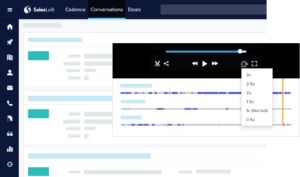Explore examples and learn practices for how to optimize the #fullcycle of your customer experience:
- Audit your customer experiences
- Align your teams
- Leverage your tech stack
In this blog we’ll focus on Generating Pipeline. Stay tuned over the next two weeks to read the other two blogs in the Consistent Customer Experience series covering Managing Deals and Engaging Customers.
Consistency makes us feel normal
Customers may not know just how much they’re being impacted by social distancing until they call your customer service line and spend 45 minutes waiting to speak with a representative- a task that previously only took 5 minutes.
How you approach the customer experience right now is critical in solidifying your company’s value in the months to come.
“Is <insert name of your company> essential to our business?”
Let’s boil it down to why: revenue.
Delivering consistently along the customer lifecycle – from generating pipeline to earning and keeping customers – is how you ensure your current customer base remains satisfied (e.g. recurring revenue), while you continue to earn new customers (e.g. new customer revenue).
“In a multinational survey of 255 B2B marketers, 94% of respondents state it’s important for their company to deliver a consistent experience across various digital and offline channels.” Forrester Research, The State Of Digitized Selling, December 2019
It is important to look internally and audit your customer experience at every stage of generating pipeline.
Ensure your teams are aligned to this experience and leverage your tech stack to keep your business running efficiently.
What follows are tips for aligning your business – people, processes and tools – to the various stages of the customer experience, told through real-life examples.
One invitation to the dance
The current public health environment is forcing all business leaders to rethink the way we package and position what we sell to attract customers. Add to the challenge that most of our interactions are conducted digitally, making it increasingly more difficult to capture the attention of your prospects.
You’ve got one shot to deliver a consistent buyer experience once you’ve earned time with your prospect.
The journey you send them on must be consistent. You must update all of the interaction points your buyers have with your business (i.e. email, website, sellers, etc.) as your offers and positioning evolves.
Example:
The marketing department of a regional hotel brand has prepared an offer for those customers who have cancelled their upcoming 2020 reservations. They send an email to these customers explaining that those who rebook their vacation for stays taking place this year will receive 2 free nights.
The offer is eligible for any hotel in their franchise.
A customer receives this email and calls the booking department of the hotel chain. The booking representative has no information on the offer. She explains that she cannot honor the 2 free nights.
The customer becomes frustrated and asks to speak with a more senior representative. The senior representative reinforces the decision the previous representative made. Consequently, the customer takes action by unsubscribing from the next newsletter they receive from this hotel brand.
He cancels his loyalty points membership and leaves a negative Tripadvisor review.
Audit your prospective customer interaction points.
Challenge:
Leaders are under pressure to act quickly to recoup lost and at-risk business. This can result in cracks in the buyer experience that could be uncovered when tested.
Solution:
Before you launch a new offer, marketing program, or sales cadence, leave room in your project plan for auditing the customer experience.
Test it- secret shopper style.
Click all the links and pick-up the phone. Immerse yourself into the experience you’ve created for your buyer. As a result, you’ll uncover any issues before they do.
Continue the testing. Above all, companies and sellers need to be agile. Figure out what’s working and not working. A/B test and evolve your messaging, programs and offers to align with customer pain points.
Align your teams.
Challenge:
In this example, the marketing and reservations department are clearly not aligned.
Too many virtual meetings- and people multitasking during them- have made intra-departmental alignment all the more difficult.
Solution:
Keep your revenue teams well-versed on the marketing programs and promotional offers available to prospective customers.
And sellers, listen to your teams to understand what is slowing down deals. Surface those insights to come up with ways to keep momentum in your pipeline.
Work with your sales enablement team to help educate your sellers. This team will help you ensure you’re communicating with sales in the ways they prefer to receive information.
Leverage your tech stack.
Challenge:
The prospecting team had no visibility into the email the caller read, or the website he or she visited before calling.
Beyond having no information on the offer, they were not prepared with a talk track to help navigate the conversation. They were not prepared to answer common questions, or communicate after the call was complete.
Solution:
Your #ABM tools can give your revenue teams insights into the interactions a prospective customer has already had with your company, down to the last email they opened or last link they clicked. Ensure your ABM insights are connected with your Contacts and Accounts.
“In addition to delivering better experiences for marketers, buyers, and sellers, organizations that successfully operationalize these tools will likely gain the benefit of a 20% revenue lift.” Forrester Research, The State Of Digitized Selling, December 2019
Give your prospecting teams appropriate talk tracks to begin their conversation with the right message.
Use pre-written and relevant follow-up sales emails and phone scripts. Automate this process with Cadences. Reps can track customer sentiment in response to tactics so you can learn how well the message is landing. Even more, monitor results and continue testing messaging, tactics, and cadences to figure out what is working. 
Conversation Intelligence helps you monitor conversations and ensure reps are delivering on message.
Coach them when needed and extract best practices from your most effective reps.
In “The State of Digitized Selling” by Forrester Research, December 2019, Caroline Ernst, VP of eCommerce at Affiliated Distributors says,
“If all channels are working together with the customer in the center, then you’re helping them transact, save time, save money, and get smarter about doing their job — and that’s what we’re all working toward.”
Want more?
For Pro Tips on selling using Salesloft remotely and in this strange environment, check out our Thrive Content Hub at sal.es/thrive2020 where we will post and share more helpful content over the coming weeks.
#saleslove


